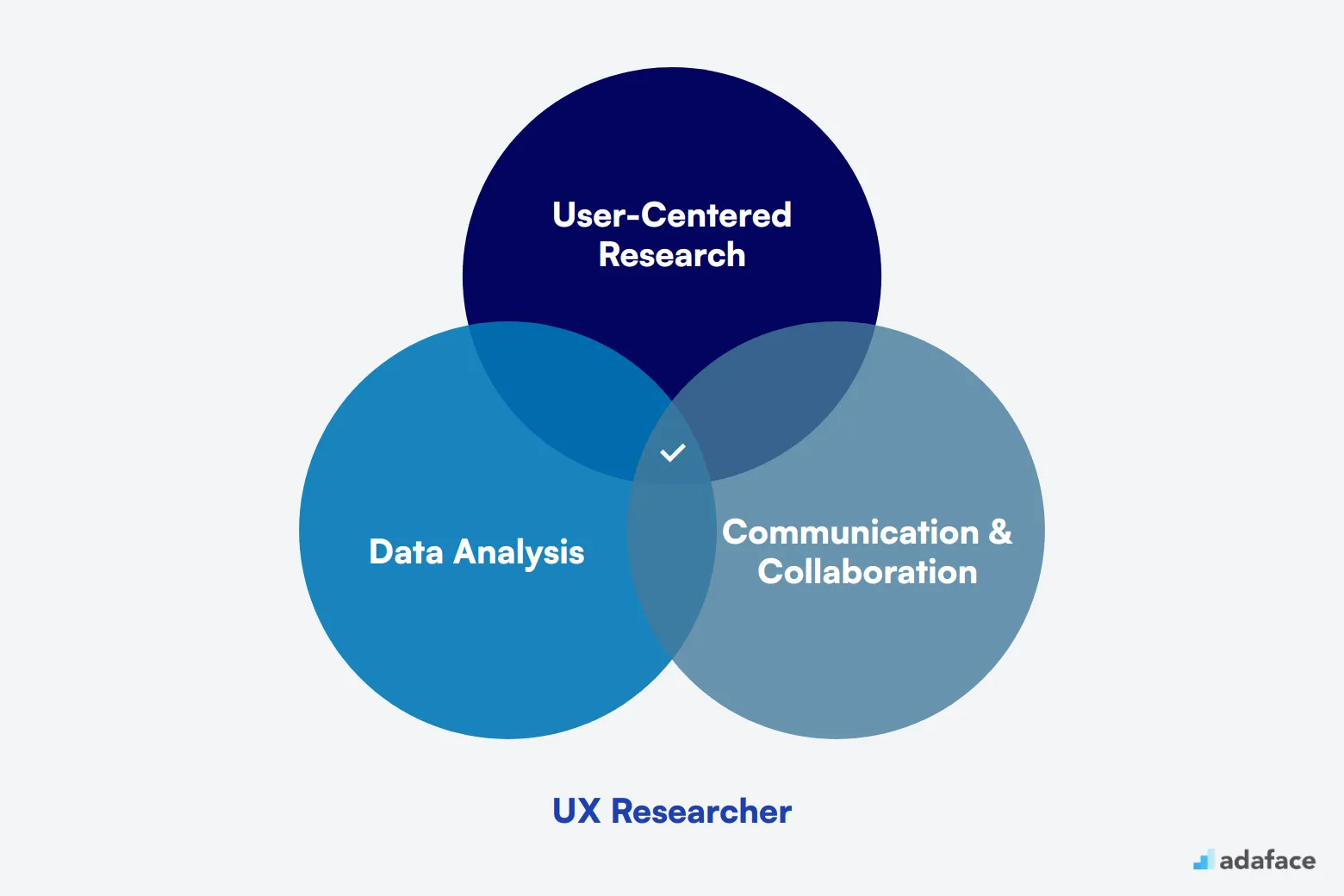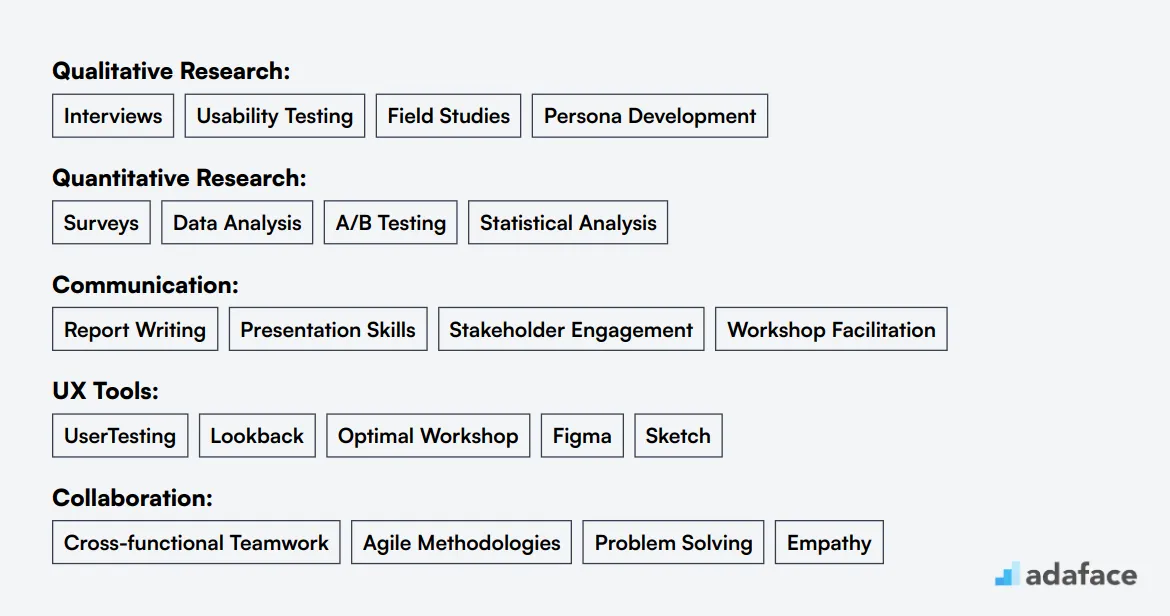Hiring a UX researcher is a strategic move to ensure your product meets user needs and expectations. Many companies overlook the significance of a dedicated UX researcher, often opting to have designers or product managers take on the role. This can lead to gaps in user understanding and ultimately affect the product's success. A specialized UX researcher provides deep insights into user behaviors and preferences, helping teams make informed design decisions.
In this article, we'll cover the key responsibilities of a UX researcher and the hiring process, including skills and qualifications to look for, how to craft an effective job description, and where to find top talent. We'll also discuss using skills tests for screening candidates efficiently.
Table of contents
Why hire a UX Researcher?
A UX Researcher can help solve critical user experience challenges in your products or services. They uncover valuable insights about user behavior, preferences, and pain points that can drive product improvements and boost user satisfaction.
Before committing to a full-time hire, assess your ongoing UX research needs. For smaller projects or to test the waters, consider working with a consultant. As your UX research requirements grow more complex and frequent, bringing a dedicated researcher on board becomes more beneficial.

What Does a UX Researcher Do?
A UX Researcher helps businesses understand their users' needs and behaviors to improve product design and functionality. They use various research methods to gather insights that inform the design process, ultimately enhancing user experience and satisfaction.
UX Researchers employ several day-to-day tasks to achieve their goals. These include:
- Conducting user interviews and surveys to gather data.
- Analyzing collected data to discern patterns and insights.
- Collaborating with designers and product teams to integrate findings into product development.
- Creating user personas and journey maps to represent different user types.
- Presenting research findings to stakeholders to guide decision-making.
For a comprehensive look at the skills required for a UX Researcher, you can explore our detailed blog post.
UX Researcher Hiring Process
Hiring a UX Researcher typically takes around 6-8 weeks. The timeline may vary depending on your organization's speed and the number of candidates you consider.
- Step 1: Start with a clear and detailed job description. Post it on relevant job boards and platforms to attract suitable candidates. You can find a comprehensive UX Researcher job description here.
- Step 2: Expect to receive resumes within a week. Shortlist candidates based on their experience and qualifications.
- Step 3: Move to skill testing, which may include practical assessments or case studies relevant to UX research. This step can take about a week.
- Step 4: Conduct interviews with the shortlisted candidates. Focus on their analytical thinking, problem-solving abilities, and cultural fit.
- Step 5: Finally, extend an offer to the best candidate, and be prepared for negotiations.
Overall, the hiring process can span about 1-2 months. It’s important to be thorough at each stage to ensure you find the right fit for your team. In the following sections, we will further explore each step in detail and provide handy checklists for your convenience.
Skills and Qualifications to Look for in a UX Researcher
When hiring a UX Researcher, it's important to create an accurate candidate profile to suit your company's specific needs. It's tricky because what's necessary for one organization might only be a nice-to-have for another. For example, while qualitative research skills could be a must-have for your role, others might prioritize quantitative analysis.
Clearly defining what's required versus what's preferred can help you find the right match. Required qualifications often include a Bachelor's degree in a related field and practical experience with qualitative methods like interviews and usability testing. On the other hand, preferred skills such as proficiency in UX design tools like Sketch or Figma can give a candidate an edge. Understanding these distinctions can streamline your hiring process.
For further insights on how to align your hiring process with the skills you require, explore the Adaface skill mapping resource. This tool can provide valuable guidance to ensure you focus on the right competencies.
| Required skills and qualifications | Preferred skills and qualifications |
|---|---|
| Bachelor's degree in Human-Computer Interaction, Psychology, or related field | Master's degree in a related field |
| Two or more years of UX research experience | Experience in quantitative research methods and data analysis |
| Proficiency in qualitative research methods such as interviews and usability testing | Experience working in a cross-functional team environment |
| Strong verbal and written communication skills | Proficiency with UX design tools like Sketch or Figma |
| Experience with research tools such as UserTesting, Lookback, or similar | Experience in the industry of the hiring company (e.g., tech, healthcare) |
How to Write a UX Researcher Job Description
Creating an effective UX Researcher job description is key to attracting talented candidates. Once you have a candidate profile ready, the next step is to capture that information in the job description to engage the right individuals.
- Highlight key responsibilities and impact: Clearly define what the UX Researcher's role entails and how their work will contribute to the overall success of your projects. For instance, emphasize tasks like conducting user research, analyzing data, and collaborating with design teams to improve user experience.
- Balance technical expertise with soft skills: While listing the technical skills like proficiency in usability testing and familiarity with design software, don't forget to include soft skills such as empathy, communication, and problem-solving. These are crucial for understanding and advocating for user needs.
- Showcase your company's unique advantages: Explain what sets your organization apart, such as innovative projects, opportunities for professional growth, or a collaborative work environment. Highlighting these aspects can make your job offer more attractive to top-tier candidates.
For more detailed guidance, refer to our comprehensive UX Researcher job description page.
Top Platforms to Hire UX Researchers
Now that you have a well-crafted job description, it's time to post it on job listing sites to attract potential UX researchers. Leveraging online assessment platforms can help streamline your hiring process and identify top talent efficiently.
Beyond these popular platforms, there are several other options to explore. Professional networks, UX-specific job boards, and freelance marketplaces can also be valuable sources for finding skilled UX researchers. Consider using a mix of these platforms to cast a wider net and increase your chances of finding the perfect candidate for your team.
How to screen UX Researcher resumes?
When you're faced with a pile of UX Researcher resumes, screening is your first step to finding the right candidate. By narrowing down your options from the start, you save time and focus your efforts only on the most promising applicants.

Start by identifying key skills and qualifications related to UX research. Keywords like 'qualitative research', 'usability testing', and 'communication skills' should catch your eye. As you sift through resumes, look for these terms to ensure the candidates possess the necessary expertise. You might find the UX Researcher interview questions helpful in understanding the skills to focus on.
Incorporating AI tools can further refine your screening process. Tools like ChatGPT can quickly analyze resumes, highlighting the presence of your desired keywords. By inputting specific criteria, you allow the AI to efficiently rank candidates based on how well they match your needs.
Here's a prompt to get started:
TASK: Screen resumes to match job description for UX Researcher role
INPUT: Resumes
OUTPUT: For each resume, provide following information:
- Email id
- Name
- Matching keywords
- Score (out of 10 based on keywords matched)
- Recommendation (detailed recommendation of whether to shortlist this candidate or not)
- Shortlist (Yes, No or Maybe)
RULES:
- If you are unsure about a candidate's fit, put the candidate as Maybe instead of No
- Keep recommendation crisp and to the point.
KEYWORDS DATA:
- Qualitative Research (Interviews, Usability Testing)
- Communication Skills (Report Writing, Presentation)
- UX Tools (UserTesting, Lookback)
For more resources on assessment processes, take a look at skills assessment tools.
Recommended Skills Tests to Screen UX Researchers
To hire a qualified UX researcher, it’s important to evaluate their skills beyond the resume. Skill tests are a reliable method to assess the candidates’ ability to handle real-world challenges. Here are our top picks for skills tests that can help you in the hiring process:
UI/UX Design Test: This test evaluates the candidate's understanding of user-centered design principles and their ability to create intuitive and engaging user interfaces. It's a great way to gauge their design thinking and problem-solving skills. Explore the UI/UX Design Test.
Communication Test: UX researchers need to effectively communicate their findings and collaborate with cross-functional teams. This test assesses the candidate's ability to articulate ideas clearly and engage with stakeholders. Check out the Communication Test.
Critical Thinking Test: The ability to think critically and analyze data is a core skill for UX researchers. This test helps identify candidates who can assess situations and make informed decisions. Learn about the Critical Thinking Test.
Attention to Detail Test: UX researchers must pay close attention to detail to ensure user needs are met. This test evaluates the candidate's focus and accuracy in handling detailed tasks. Discover the Attention to Detail Test.
Problem Solving Test: Essential for any UX researcher, this test assesses the candidate's ability to identify problems and come up with effective solutions. It's perfect for understanding how they tackle UX challenges. Find out about the Problem Solving Test.
Hire the Best UX Researchers
In this blog post, we've explored why hiring a UX researcher is important, what their role entails, and the key skills and qualifications to look for. We've also covered how to write an effective job description and the steps involved in the hiring process, from resume screening to conducting skills tests.
If there's one takeaway to remember, it's the importance of using clear job descriptions and relevant skills tests to make informed hiring decisions. Utilizing skill assessments like the UI/UX Design Test can help you identify candidates who possess the right skills to thrive in the role. This approach ensures you find the right fit for your team without any guesswork.
UI/UX Design Test
FAQs
Hiring a UX researcher is crucial for understanding user needs and improving the overall user experience of your product. They help identify pain points and opportunities, ensuring the product is user-friendly and aligns with market demand.
A UX researcher conducts user research, analyzes data, and provides insights to inform design decisions. They use various research methods like interviews, surveys, and usability testing to understand user behaviors and needs.
Key skills include strong analytical abilities, excellent communication skills, proficiency in research methodologies, and experience with UX design principles. Familiarity with user research tools and data analysis software is also beneficial.
Focus on outlining the key responsibilities, required skills, and qualifications. Highlight the importance of user research in your company and what you expect the UX researcher to achieve.
Consider using platforms like LinkedIn, specialized job boards, and recruitment agencies. You can also explore UX communities and forums to find potential candidates.
Look for relevant experience, a strong portfolio of past research work, and an understanding of various research methodologies. Consider using structured interviews and skills assessments to evaluate candidates' suitability.
Yes, skills tests can be extremely helpful in objectively assessing a candidate's expertise and problem-solving abilities. They provide insight into how a candidate approaches user research tasks.

40 min skill tests.
No trick questions.
Accurate shortlisting.
We make it easy for you to find the best candidates in your pipeline with a 40 min skills test.
Try for freeRelated posts



